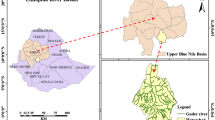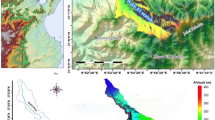Abstract
An attempt has been made in this study to quantify the soil loss rate and their spatial distribution using a hybrid model of geographic information system coupled with fuzzy logic technique. Shewa Semien zone, Ethiopia, characterized by steep slopes and high rainfall was chosen for this study. A total of ten thematic layers pertaining to soil erosion study, namely rainfall erosivity factor, topographic factor, drainage density factor, plane curvature factor, crop management factor, soil erodibility factor, silt percentage factor, hydraulic conductivity factor, soil texture factor, and stream power index, were analyzed. Fuzzy logic membership values were assigned to different classes within each thematic layer depending on their erosion potential. The final output raster was reclassified into four zones depending on the fuzzy membership values: slight, moderate, severe, and very severe zones with their fuzzy membership values varied from 0 to 0.05, 0.05 to 0.30, 0.30 to 0.65 and 0.65 to 1.00, respectively. The “very severe” erosion zone characterized with the soil loss rate of 67.84–96.26 t/ha/year was found to cover an areal extent of 400,524.92 ha which demands immediate conservation measures. Slope was found as a major factor determining the severity of soil loss rate spatially. The influence of slope, erosivity, stream power index and drainage density toward soil loss rate is documented well in this study. This study testifies the efficiency of the hybrid model for the demarcation of erosion hazard zones and can be applied at continental scale for landscape development.







Similar content being viewed by others
References
Aklilu A, Stroosnijder L, de Graaff J (2007) Long-term dynamics in land resource use and the driving forces in the Beressa watershed, highlands of Ethiopia. J Environ Manag 83:448–459
Amsalu A, de Graaff J (2007) Determinants of adoption and continued use of stone terraces for soil and water conservation in an Ethiopian highland watershed. Ecological Economics 61: 294–302. FAO. 1986. Ethiopian highlands reclamation study, Ethiopia. Final Report, FAO, Rome
Berhan G, Woldeamlak B, Bräuning A (2014) Model-based characterization and monitoring of runoff and soil erosion in response to land use/land cover changes in the Modjo watershed. Land Degrad Dev. https://doi.org/10.1002/ldr.2276
Bewket W (2002) Land cover dynamic since the 1950s in Chemoga watershed, Blue Nile basin, Ethiopia. Mt Res Dev 22:263–269
Billi P (2015) Geomorphological landscapes of Ethiopia. In: Billi P, (eds), Landscapes and landforms of Ethiopia, World Geomorphological Landscapes. Springer: Dordrecht. London. https://doi.org/10.1007/978-94-017-8026-2015
Davidson DA, Theocharopoulos SP, Bloksma RJ (1994) A land evaluation project in Greece using GIS and based on Boolean and fuzzy set methodologies. Int J GIS 8:369–384
De Gruijter JJ, Walvoort DJJ, Van Gaans PFM (1997) Continuous soil maps—a fuzzy set approach to bridge the gap between aggregation levels of process and distribution models. Geoderma 77:169–195
Descheemaeker K et al (2008) Runoff curve numbers for steep hillslopes with natural vegetation in semi-arid tropical highlands, northern Ethiopia. Hydrol Process 22:4097–4105. https://doi.org/10.1002/hyp.7011
Fazzini M, Bisci C, Billi P (2015) The climate of Ethiopia. In: Billi P (ed) Landscapes and landforms of Ethiopia. World geomorphologic landscapes. Springer, Dordrecht
Gashaw T, Tulu T, Argaw M (2017) Erosion risk assessment for prioritization of conservation measures in Geleda watershed, Blue Nile basin. Ethiopia Environ Syst Res 6(1):1–14
Kampichler C, Barthel J, Wieland R (2000) Species density of foliage-dwelling spiders in field margins: a simple, fuzzy rule-based model. Ecol Model 129:87–99
McBratney AB, Odeh IOA (1997) Application of fuzzy sets in soil science; fuzzy logic, fuzzy measurements and fuzzy decisions. Geoderma 77:85–113
Mekuriaw A, Heinimann A, Zeleke G, Hurni H (2018) Factors infuencing the adoption of physical soil and water conservation practices in the Ethiopian highlands. Int Soil Water Conserv Res 6:23–30
Metternicht G (2001) Assessing temporal and spatial changes of salinity using fuzzy logic, remote sensing and GIS. Foundations of an expert system. Ecol Model 144:163–179
Miheretu BA, Yimer AA (2018) Estimating soil loss for sustainable land management planning at the Gelana sub-watershed, Northern Highlands of Ethiopia. Int J River Basin Manag 16(1):41–50
Minstry of Agriculture (MOA) (2011) Guideline on Irrigation Agronomy. Natural Resources Management Directorate, Natural Resource Sector and the Ministry of Agriculture, Ethiopia
Molla T, Sisheber B (2017) Estimating soil erosion risk and evaluating erosion control measures for soil conservation planning at Koga watershed in the highlands of Ethiopia. Solid Earth 8:13–25
Nisar K, Ahamed TR, Gopal RK, Murthy JSR (2000) Fuzzy class membership approach to soil erosion Modelling. Agric Syst 63:97–110
Nunnari G, Nucifora A, Randieri C (1998) The application of neural techniques to the modelling of time-series of atmospheric pollution data. Ecol Model 111:187–205
Nyssen J et al (2004) Human impact on the environment in the Ethiopian and Eritrean highlands—a state of the art. Earth Sci Rev 64:273–320
Samuel G, et al (2016) Economics of land degradation and improvement in Ethiopia. In: Nkonya E et al. (eds.), Economics of land degradation and improvement—a global assessment for sustainable development. https://doi.org/10.1007/978-3-319-19168-3
Sonneveld BGJS, Keyzer MA (2003) Land under pressure: soil conservation concerns and opportunities for Ethiopia. Land Degrad Dev 14:5–23
Subhatu A, Lemann T, Hurni K, Portner B, Kassawmar T, Zeleke G, Hurni H (2017) Deposition of eroded soil on terraced croplands in Minchet catchment, Ethiopian Highlands. Int Soil Water Conserv Res 5:212–220
Tamene L, Vlek PLG (2008) Soil erosion studies in northern Ethiopia. In: Braimoh AK, Vlek PLG (eds) Land use and soil resources. Springer, Berlin
USGS Earth Explorer (http://www.earthexplorer.usgs.gov)
Wang F, Hall G, Subaryono (1990) Fuzzy information representation and processing in conventional GIS software: database design and application. Int J GIS 4:261–283
Woldemariam GW, Iguala AD, Tekalign S, Reddy RU (2018) Spatial modeling of soil erosion risk and its implication for conservation planning: the case of the Gobele Watershed, East Hararghe Zone. Ethiopia Land 7:25
Zadeh L (1965) Fuzzy sets. Inf Control 8:338–353
Zerihun M, Mohammedyasin MS, Sewnet D, Adem AA, Lakew M (2018) Assessment of soil erosion using RUSLE, GIS and remote sensing in NW Ethiopia. Geoderma Reg 12:83–90
Acknowledgements
The corresponding Author is thankful to Department for Management of Science and Technology Development, Ton Duc Thang University, Ho Chi Minh City, Vietnam. Faculty of Environment and Labour Safety, Ton Duc Thang University, Ho Chi Minh City, Vietnam. The Authors are also thankful to Department of Hydraulic and Water Resources Engineering, Debre Tabor University, Ethiopia.
Author information
Authors and Affiliations
Corresponding author
Ethics declarations
Conflict of interest
On behalf of all authors, the corresponding author states that there is no conflict of interest.
Additional information
Editorial responsibility: Samareh Mirkia.
Rights and permissions
About this article
Cite this article
Halefom, A., Ahmad, I. & Dar, M.A. Soil loss rate estimation using a hybrid model of geographic information system coupled with fuzzy logic technique. Int. J. Environ. Sci. Technol. 19, 421–432 (2022). https://doi.org/10.1007/s13762-021-03178-5
Received:
Revised:
Accepted:
Published:
Issue Date:
DOI: https://doi.org/10.1007/s13762-021-03178-5




